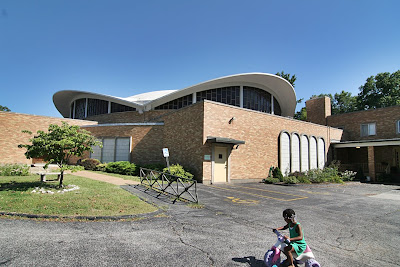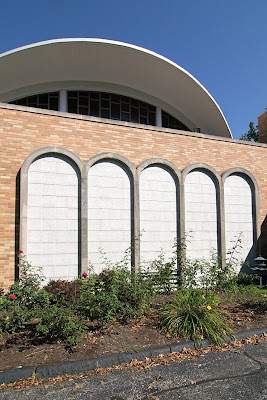 1160 St. Cyr Road, Bellefontaine Neighbors, MO
1160 St. Cyr Road, Bellefontaine Neighbors, MO
We were driving down Bellefontaine Road and we came to the intersection of Bellefontaine and St. Cyr. I say to Rob, “You know, I’ve never taken a left down this road. Let’s see what’s down there.”
As I turn, Rob says there’s this really great modern church at the top of the hill with a swooping concrete roof. He’s covered it on his website…and…I didn’t hear another word he said.
From the first glance of it, I was stunned. Pulling into the parking lot, I was overcome. I’d obviously been down this road before, many times, a long, long time ago. This was the church my Grandma Weiss went to and I’d been inside it many, many times.
 You know those flashback scenes in movies? That’s exactly what happened to me standing in the parking lot, staring up at the church. A dozen old reels of mental film were unspooling concurrently at a rapid pace.
You know those flashback scenes in movies? That’s exactly what happened to me standing in the parking lot, staring up at the church. A dozen old reels of mental film were unspooling concurrently at a rapid pace.
The First Reel:
Easter of 1973, and what turned out to be the last time I was in this church. My parents had recently divorced, but Dad picked me up to go to church with him and his mother. I was decked out in a white and brown smock dress and a pair of fake leather white clogs with dark brown wedge heels (come on, it was 1973!). Oh, how I loved those clogs, and the thick hollow sound they made as I dragged my heels.
As we walked up the sidewalk to the auditorium, Dad was getting annoyed with that sound.
“Toby, pick up your heels.”
Thunk, thunk, thunk.
“Toby, stop dragging your feet.”
Thunk, thunk, thunk.
By now we’re in the auditorium, heading for a pew, and the clogs made a whole new sound on the carpet: thwook, thwook, thwook.
“Toby, I told you to stop dragging your heels!”
Thwook, thwook – oops!
Dad abruptly pulls me up into the air by one hand, and swats my butt. I’m swaying back and forth with each swat, and the clogs fall off my feet and land with a loud “da-thunk thunk.” I look down at my clogs contrasted against the red carpet, and tears of embarrassment fill my eyes…. fade out.
 Rob and I peer in through the doors, and I see small glimpses of the auditorium, just enough for more film reels to unwind. I had total recall of every single form, line and texture of the interior. Being too young to listen to what was being said at the alter, I spent every service visually scanning every detail of that room. I could feel the childhood sensation of tracing those concrete arches as they dived into the wooden trellis screens. I could recall my fantasies of swinging like a trapeze artist from the braided support cables.
Rob and I peer in through the doors, and I see small glimpses of the auditorium, just enough for more film reels to unwind. I had total recall of every single form, line and texture of the interior. Being too young to listen to what was being said at the alter, I spent every service visually scanning every detail of that room. I could feel the childhood sensation of tracing those concrete arches as they dived into the wooden trellis screens. I could recall my fantasies of swinging like a trapeze artist from the braided support cables.
These flashbacks were intense and vivid, and they came on with such force because they had been suppressed for so long. Not once over all these years had I thought of this building; it had long ago left conscious memory. But seeing one small piece of it from a distance unlocked that brain sector, and turns out I knew that building almost as well as the people who designed and built it. And then I forgot all about it, since I got out of going to this church – or any church – after that Easter Clog Debacle.
This part of North County was once a happening place, which is why my grandparents moved there. As the website of this municipality relays, “From the year 1950 to the year 1960, Bellefontaine Neighbors experienced a period of very rapid population growth, the 766 people in 1950 having increased to 13,650 people by 1960.” The Archdiocese website says this church was built in 1951, but a corner stone says 1965, so maybe they had to add on to accommodate the crowds. By the early 1980s, most of our family had moved away from the area, leaving Grandma – who never had a drivers license – hard pressed to get a regular ride to church, even though she lived a quarter of a mile away. This was a common story, a tale also known as White Flight, and was a contributing factor to it being shut down by The Church in 2005.
 So anyway, that is the unique power of the built environment: physical proof of our pasts, depositories of memories our brains can’t hold because of all the dates, numbers and names we have to remember daily. Buildings are bookmarks in the story of our lives, and in the case of this building, it is the most interesting and compelling character in the short chapter of my church-going years.
So anyway, that is the unique power of the built environment: physical proof of our pasts, depositories of memories our brains can’t hold because of all the dates, numbers and names we have to remember daily. Buildings are bookmarks in the story of our lives, and in the case of this building, it is the most interesting and compelling character in the short chapter of my church-going years.
